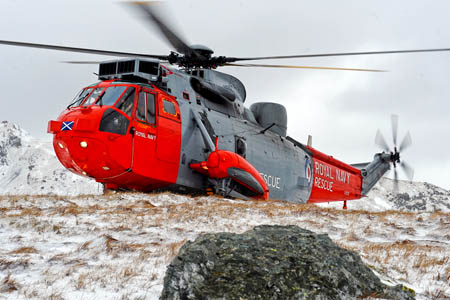The Royal Navy’s search and rescue crews at HMS Gannet have topped the rescue league tables for the fifth year running.
The Sea King helicopters at the Ayrshire base were called out 298 times last year and rescued 240 people.
Among their most surprising sorties was the rescue of Adam Potter, who fell 300m (1,000ft) from near the summit of Sgurr Choinnich Mòr in the Grey Corries. The rescue crew expected to be dealing with a fatality, but discovered a dazed Mr Potter at the base of the mountain’s crags checking his map trying to work how he got there.
He went on to summit Everest later in the year.
The Gannet crew’s hairiest rescue came in December when a lone walker suffered an ankle injury on Beinn Sgulaird in Argyll.
In sub-zero temperatures, the helicopter was forced to ascend slowly and perilously close to the mountain’s rock face, which was the only visual reference available. The crew was then immediately sent to help Glencoe Mountain Rescue Team with a further two climbers lost on the Aonach Eagach ridge.
Statistics from the Defence Analytical Services Agency show Gannet’s crews spent more than 600 hours on rescue missions, the longest of which was a km (465-mile) round trip from the base at Prestwick on a medical mission to Wick in Caithness, a sortie lasting almost 12 hours.
Over a five year period, HMS Gannet has been called to 1,865 emergencies, rescuing 1,575 people, many of them climbers, mountaineers and hillwalkers in Scotland and northern England and Northern Ireland.
HMS Gannet’s commanding officer, Lieutenant Commander Debdash Bhattacharya, said: “Like all emergency services we work under significant pressure and always aim to provide the best service we possibly can. Frequently lives depend on it.
“It is with huge pride that I am able to commend and thank the whole team at HMS Gannet – from the aircrews to the engineers, the met office to the administrative staff, and all the other supporting personnel like security staff – for, once again, maintaining and running this well-oiled operation which saves lives at a moment’s notice in often terrible conditions across an area of 98,000 square miles.
“Our achievement is enabled by deep engineering expertise and high levels of professionalism and dedication on the part of the aircrew and supporting staff.
“Given that the average number over the last half decade is 372 per year, 2011 was actually a slightly quieter one, though no less taxing for the crews.
“Nonetheless, this is an exceptional achievement and one of which each and every person involved with operations at HMS Gannet should be extraordinarily proud.”
The Royal Navy also operates a search and rescue base at Culdrose in Helston, Cornwall, where Naval Air Squadron 771 recorded 244 call outs in the same 12 month period.
The RAF operates its Sea King SAR helicopters from six bases around Britain and the Coastguard also operates Sikorsky and AugustaWestland aircraft from four bases in Scotland and England. The three SAR services provide support for the UK’s volunteer mountain rescue teams.
The Royal Navy and RAF crews are due to lose their search and rescue role in 2017 when the service is due to be privatised. CHC, which currently has the contract for the Coastguard SAR helicopter services, is thought to be on the brink of losing out to rivals Bristow at the two Scottish bases in an announcement due this week by the Department for Transport, in a stop-gap arrangement until the full privatisation in five years’ time.

Dave R
08 February 2012Great effort and much appreciated by your average Jo Hill Walker - Thanks in anticipation of hopefully never meeting you but glad your there non the less